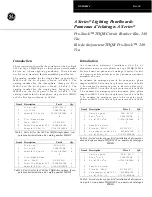
Line up the breaker in front of the compartment where it will be installed; then raise
it slightly above the height of the drawout Rail assembly.
Pull out the two rails being cautious not to position anyone underneath the
suspended load. Pulling from the middle of the tie bar connecting the two rails and
lifting up slightly will help the rails to slide out more easily.
Lower the breaker down on the Rails.
Remove the lifting bar and or chains.
Push the breaker into the compartment slowly while observing the alignment of the
rejection pins, secondary disconnects and opening of the optional shutter. A
compartment interlock rod in the right front will ride over a cam and drop into
position in the DISCONNECT position.
When fully installed to the DISCONNECT position, the racking cams will stop on the
racking pins in the compartment and the breaker will be ready to rack in.
Remove the racking tool. (Figure 29) from the storage location on the breaker front
panel and extend the torque bar from inside the handle.
Use a blade-type screwdriver in the slot or rack-out-lock of the breaker (Figure 30),
and turn it clockwise (to the right) so that the racking handle shutter opens.
While turning the screwdriver to the right with the shutter open, insert the racking
tool in the handle insertion hole so that it engages with the racking mechanism, and
remove the screwdriver (Figure 30).
Rotating clockwise ~37 turns racks the circuit breaker all the way into the compart-
ment.
As the breaker approaches the TEST position, a spring charging motor or under-
voltage release if installed may operate. (~ 9 racking turns).
Continue rotating the racking handle clockwise until the position indicator first
shows TEST; then CONNECTED.
When approaching the CONNECTED position, more torque for turning the racking
handle is normal as the primary finger clusters engage with the primary bus stabs.
At the end of 37 to 37-1/2 rotations, the breaker is in its maximum travel position. At
this point the primary disconnect fingers have completely engaged with the primary
bus stabs.
Remove and store the racking handle in its storage location.
Dropping a breaker can result in injury or death.
Make sure that the lifting bar “J” hooks or generic chain-hooks are secured and
locked in place.
Figure 34
AKD-10 Using ABB Lifting bar and hoist
C
Summary of Contents for AKD-10
Page 36: ...11 14 22 21 31 34 42 41 C2 C1 51 54 62 61 71 74 82 81 91 94 02 01 45 48 R1 R2 C ...
Page 38: ...C ...
Page 43: ...NOTES 1 WP WavePro fixed connection point C ...
Page 51: ...ONLY for 3200A Figure 48 Steps in Exploded Views for 3200A WPS 32 WPH 32 WPX 32 C ...
Page 52: ...ONLY for 3200A Figure 49 Steps in Exploded Views for 4000A WPS 40 WPX 40 C ...
Page 53: ...Figure 50 Steps in Exploded Views for 5000A WPS 50 WPX 50 ONLY for 3200A C ...
Page 65: ...Figure 64 Wiring of WP 4000A breaker with FAN control unit C ...
Page 74: ...Figure 75 Figure 76 WPF 16 with special 2500A Fuse WPF 16 2500A Fuse Tang Positions 74 C ...







































